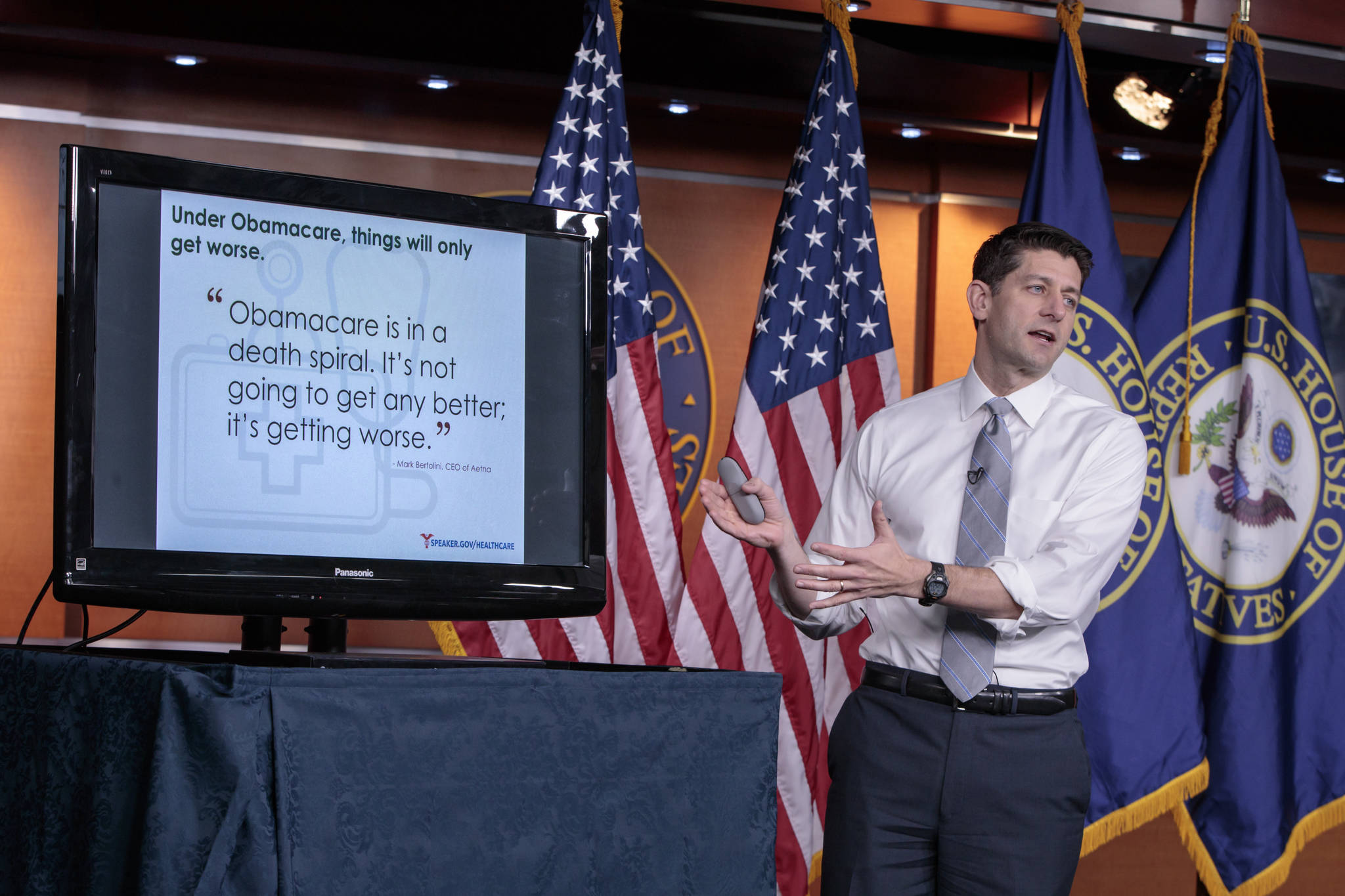WASHINGTON — Fourteen million Americans would lose coverage next year under House Republican legislation remaking the nation’s health care system, and that number would balloon to 24 million by 2026, Congress’ budget analysts projected Monday. Their report deals a stiff blow to a GOP drive already under fire from both parties and large segments of the medical industry.
The Congressional Budget Office report undercuts a central argument President Donald Trump and Republicans have cited for swiftly rolling back the 2010 health care overhaul: that the insurance markets created under that statute are “a disaster” and about to implode. The congressional experts said the market for individual policies “would probably be stable in most areas under either current law or the (GOP) legislation.”
The report also flies in the face of Trump’s talk of “insurance for everybody,” which he stated in January. He has since embraced a less expansive goal — to “increase access” — advanced by House Speaker Paul Ryan and other Republicans.
Health secretary Tom Price told reporters at the White House the report was “simply wrong” and he disagreed “strenuously,” saying it omitted the impact of additional GOP legislation and regulatory changes the Trump administration plans.
In a signal of trouble, Rep. Mark Walker, R-N.C., leader of a large group of House conservatives, said the report “does little to alleviate” concerns about the bill including tax credits considered too costly.
The budget office’s estimates provide a detailed, credible appraisal of the Republican effort to unravel former President Barack Obama’s 2010 overhaul. The office has a four-decade history of even-handedness and is currently headed by an appointee recommended by Price when he was a congressman. Trump has repeatedly attacked the agency’s credibility, citing its significant underestimate of the number of people who would buy insurance on state and federal exchanges under “Obamacare.”
On the plus side for Republicans, the budget office said the GOP measure would reduce federal deficits by $337 billion over the coming decade. That’s largely because it would cut the federal-state Medicaid program for low-income Americans and eliminate subsidies that Obama’s law provides to millions of people who buy coverage.
The report also said that while the legislation would push premiums upward before 2020 by an average of 15 to 20 percent compared to current law, premiums would move lower after that. By 2026, average premiums for individuals would be 10 percent lower than under Obama’s statute, it said.
The GOP bill would obliterate the tax penalties Obama’s law imposes on people who don’t buy coverage, and it would eliminate the federal subsidies reflecting people’s income and premium costs for millions. It would instead provide tax credits based largely on recipients’ ages, let insurers charge more for older people and boost premiums for those who let coverage lapse.
It would phase out Obama’s expansion of Medicaid to 11 million additional low earners, cap federal spending for the entire program, repeal taxes the statute imposes and halt federal payments to Planned Parenthood for a year.
Administration officials took strong issue with the budget office’s projections of lost coverage.
“We believe that our plan will cover more individuals and at a lower cost and give them the choices that they want,” Price said.
Ryan, R-Wis., said the GOP legislation “is not about forcing people to buy expensive, one-size-fits-all coverage. It is about giving people more choices and better access to a plan they want and can afford.” In fact, he said on Fox News Channel that the CBO report “exceeded my expectations.”
Not in a good way, Democrats said. Senate Minority Leader Chuck Schumer of New York said the projections show “just how empty the president’s promises, that everyone will be covered and costs will go down, have been.”
“I hope they would pull the bill. It’s really the only decent thing to do,” said House Minority Leader Nancy Pelosi of California.
The American Medical Association, which has opposed the Republican bill because it would reduce coverage, said the report shows the legislation would cause “unacceptable consequences.”
Two House committees approved the legislation last week, and Ryan wants to bring it to the full House next week. Though many Republicans back the bill, conservatives say it doesn’t go far enough in repealing Obama’s law, while moderates whose states used the statute to expand Medicaid don’t want people losing coverage.
GOP leaders hope the Senate will consider the measure before breaking for an early April recess. Opposition from both ends of the Republican spectrum suggests senators might demand significant changes.
The budget office attributed projected increases in uninsured Americans to the GOP bill’s elimination of tax penalties for people who don’t buy insurance, reduced federal subsidies for many people who buy policies and the Medicaid reductions.
By 2026, the office estimated, a total of 52 million people would lack insurance, including 28 million expected to lack coverage under Obama’s statute.
Though Republican tax credits would be less generous than Obama’s, the combination of those credits and other changes to lower premiums would attract enough healthy people to stabilize markets under the new plan, the report said.
The budget office sees federal spending on Medicaid declining by $880 billion over the coming decade — about 25 percent lower than current projections. That would push about 14 million low-income people off the program.
Average premiums are ultimately expected to fall, but that would vary for people of different ages because, contrary to Obama’s law, Republicans would let older people be charged more.
The report estimates that individuals’ out-of-pocket costs under the GOP bill “would tend to be higher than those anticipated under current law.” That runs counter to another claim from the president — that his health care plan would offer “much lower deductibles.”
CBO had predicted 23 million people would enroll in online marketplaces under Obama’s law but the actual number was 12 million, largely because it overestimated how the individual mandate would prompt them to buy coverage.

